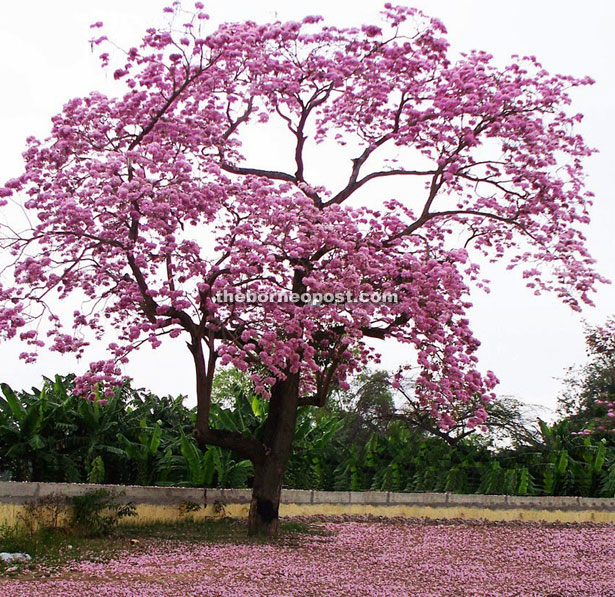TABEBUIA has been featured in the news lately as the trees planted around Kuching City have been in full bloom following a very hot spell.
This majestic avenue tree comes under the family Bignoniaceae, which comprises over 60 species of trees. It is commonly called trumpet tree, roble or tecoma.
In Kuching, we can find them planted as ornamental trees along roads such as Jalan Simpang Tiga, which had gorgeous displays recently. What we have here is mostly Tabebuia rosea in tones of pink and purple. In Singapore this tree is also planted along roadsides and blooms in April too.
Background
The tree originates from tropical and subtropical areas of the American continent from Mexico to Argentina and even the Caribbean. It is apparently the national flowering tree of El Salvador and the state tree of Venezuela. Its original name among the indigenous people of Brazil is ant wood tree.
A fast growing tree, it can reach 25 metres or more in height with a crown that is wide, stratified and irregular with few horizontal branches. The bowl is straight and comes with a channelled base portion.
Leaves are pinnate and divided into five uneven leaflets. The foliage is dark green and deciduous. The tree can tolerate wind from the coast and salty sandy loam or clayey loam.
Flowering usually occurs after a hot and dry spell. This is when the tree will definitely remind us of cherry blossoms in bloom in Japan.
It is spectacular when the entire tree canopy is covered with the pinkish purple or white flowers that are showy and trumpet-like in shape. These appear in clusters of up to 30 flowers per cluster.
These flowers will drop after awhile and cover the ground in a carpet of pink or white.
Its fruits are long pods that split to release winged seeds that rotate like a helicopter during their slow downward descent to the ground. Dispersal of the seeds would be assisted by the wind.
Cultivation
All stem and branch cuttings would generate new plants in time. As they are hardy and adaptable, they are often the first coloniser on construction sites filled with new soil.
Young trees should be fertilised during planting by applying phosphorus for root development. Too much nitrogen could cause more foliage growth and less flower buds to develop, resulting in less blooms.
It is best to only fertilise established trees after flowering to allow for new growth and foliage production.
If monthly fertilising is needed, then choose a soluble fertiliser to use throughout the season.
Use them where there is enough room for the roots to spread and the canopy to shade the ground.
They are fairly easy to establish in our soil without any help.
Tabebuia is a low maintenance tree that will thrive in almost any fertile soil. It must be grown in full sun or partial shade.
Mature trees need little watering. The old branches are brittle but can mostly withstand high winds.
The seed pods do not attract animals or insects and the tree is seldom bothered by pests.
Other uses
Apparently the tree was traditionally used to treat anaemia, internal parasites and constipation.
The flowers, leaves and roots are also used to reduce fevers and pain, as well as treat tonsil inflammation.
Do send me an email if you need any details, or have questions, comments or suggestions.
Wishing all our Dayak readers Selamat Hari Gawai. Happy gardening.

